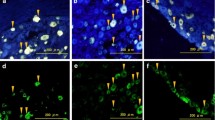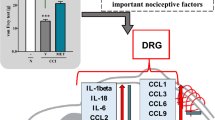Abstract
This study was designed to characterize the effects of low doses (0.5–5 ng) of pro-inflammatory cytokines, interleukin-1 beta (IL-1β), interleukin-6 (IL-6), and tumor necrosis factor (TNF), on the neural activity of dorsal root ganglion (DRG) in rats. The purpose of this study was to examine the effects of cytokines (IL-1β, IL-6, and TNF) on the somatosensory neural response of DRG. The release of inflammatory cytokines by an injured disc may play a critical role in pain production at nerve endings, axons, and nerve cell bodies. Herniated disc tissue has been shown to release IL-1β, IL-6, TNF, and other algesic chemicals. Their effects on nerve endings in disc and adjacent tissue may lead to low back pain and their effects on dorsal root axons and ganglia may lead to sciatica. Exposed lumbar DRGs were investigated by electrophysiologic techniques. Sham (mineral oil), control (carrier solution), or IL-1β, IL-6, or TNF at doses of 0.5, 1, and 5 ng were applied over the DRG. Baseline discharge rates as well as mechanosensitivity of the DRG and peripheral receptive fields were evaluated over 30 min. Applications of IL-1β at 1 ng resulted in an increase in the discharge rate, 5 ng resulted in an increased mechanosensitivity of the DRG in group II units. Similarly, after 1 ng TNF applications, group II units also showed an increase in mechanosensitivity of DRG and peripheral receptive fields. At low doses IL-1β and TNF sensitization of receptive fields were observed. The responses observed in the group II units indicate that a sub-population of afferent units might have long-term effects modifying the sensory input to the central nervous system. This study provides added evidence to the role of cytokines in modulating afferent activity following inflammation.




Similar content being viewed by others
References
Anzai H, Hamba M, Onda A et al. (2002) Epidural application of nucleus pulposus enhances nociresponses of rat dorsal horn neurons. Spine 27(3):E50–E55
Aoki Y, Rydevik B, Kikuchi S, Olmarker KJ (2002) Local application of disc-related cytokines on spinal nerve roots. Spine 27(15):1614–1617
Bianchi M, Dib B, Panerai AE (1998) Interleukin-1 and nociception in the rat. J Neurosci Res 53:644–650
Burke JG, Watson RW, McCormack D et al (2002) Intervertebral discs which cause low back pain secrete high levels of proinflammatory mediators. J Bone Joint Surg (Br) 84(2):196–201
Chen CY, Cavanaugh JM, Song Z et al (2003) Effects of nucleus pulposus on nerve root neural activity, mechanosensitivity, axonal morphology and sodium channel. Spine 29(1):17–25
Cunha FQ, Poole S, Lorenzetti B, Ferreria SH (1992) The pivotal role of tumor necrosis factor alpha in the development of inflammatory hyperalgesia. Br J Pharmacol (107):660–664
Eliav E, Herzberg U, Ruda MA, Bennett GJ (1999) Neuropathic pain from an experimental neuritis of the rat sciatic nerve. Pain 83:169–182
Ferreria SH, Lorenzetti BB, Bristow AF, Poole S (1988) Interleukin 1 beta as a potent hyperalgesic agent antagonized by a tripeptide analogue. Nature 334:698–700
Fukuoka H, Kawatani M, Hisamitsu T, Takeshige C (1994) Cutaneous hyperalgesia induced by peripheral injection of interleukin-1 beta in the rat. Brain Res 657(1–2):133–140
Garabedian BS, Poole S, Allchorne A, Winter J, Woolf CJ (1995) Contribution of interleukin 1beta to the inflammation-induced increase in nerve growth factor levels and inflammatory hyperalgesia. Br J Pharmacol 115:1265–1275
Gronblad M, Virri J, Tolonen J et al (1994) A controlled immunohistochemical study of inflammatory cells in disc herniation tissue. Spine 19(24):2744–2751
Habtemariam A, Gronblad M, Virri J, Seitsalo S, Karaharju E (1998) A comparative immunohistochemical study of inflammatory cells in acute-stage and chronic-stage disc herniations. Spine 23:2159–2166
Harrington JF et al (2000) Herniated lumbar disc material as a source of free glutamate available to affect pain signals through the dorsal root ganglion. Spine 25(8):929–936
Homma Y, Brull SJ, Zhang JM (2002) A comparison of chronic pain behavior following local application of tumor necrosis factor alpha to the normal and mechanically compressed lumbar ganglia in the rat. Pain 95(3):239–246
Junger H, Sorkin LS (2000) Nociceptive and inflammatory effects of subcutaneous TNF alpha. Pain 85(1–2):145–151
Kallakuri S, Cavanaugh JM, Takebayashi T, Ozaktay AC et al (2005) The effects of epidural application of allografted nucleus pulposus in rats on cytokine expression, limb withdrawal and nerve root discharge. Eur Spine J 14(10):956–964
Kang JD, Georgescu HI, McIntyre-Larkin L, Stefanovic-Racic M, Donaldson WF 3rd, Evans CH (1996) Herniated lumbar intervertebral discs spontaneously produce matrix metalloproteinases, nitric oxide, interleukin-6 and prostaglandin E2. Spine 21(3):271–277
Kawakami M, Tamaki T, Weinstein JN et al (1996) Pathomechanisms of pain-related behavior produced by allografts of intervertebral disc in the rat. Spine 21(18):2101–2107
Kayama S, Konno S, Olmarker K et al (1996) Incision of the annulus fibrosus induces nerve root morphologic, vascular, and functional changes. An experimental study. Spine 21(22):2539–2543
Kayama S, Olmarker K, Larsson K et al (1998) Cultured, autologous nucleus pulposus cells induce functional changes in spinal nerve roots. Spine 23(20):2155–2158
Kuslich SD, Ulstrom CL, Michael CJ (1991) The tissue origin of low back pain and sciatica: a report of pain response to tissue stimulation during operation on the lumbar spine using local anesthesia. Orthop Clin North Am 22(2):181–187
Liu B, Li H, Brull SJ, Zhang JM (2002) Increased sensitivity of sensory neurons to tumor necrosis factor alpha in rats with chronic compression of the lumbar ganglia. J Neurophysiol 88(3):1393–1399
McCarron RF, Wimpee MW, Hudkins PG et al (1987) The inflammatory effect of nucleus pulposus. A possible element in the pathogenesis of low back pain. Spine 12(8):760–764
Oka T, Oka K, Hosoi M, Hori T (1995) Intracerebroventricular injection of interleukin-6 induces thermal hyperalgesia in rats. Brain Res 692(1–2):123–128
Olmarker K, Larsson K (1998) Tumor necrosis factor alpha and nucleus-pulposus-induced nerve root injury. Spine 23(23):2538–2544
Olmarker K, Myers R (1998) Pathogenesis of sciatic pain: role of herniated nucleus pulposus and deformation of spinal nerve root and dorsal root ganglion. Pain 78:99–105
Olmarker K, Rydevik B (2001) Selective inhibition of tumor necrosis factor alpha prevents nucleus pulposus-induced thrombus formation, intraneural edema, and reduction of nerve conduction velocity. Possible implications for future pharmacologic treatment strategies of sciatica. Spine 26(8):863–869
Olmarker K, Nordborg C, Larsson K et al (1996) Ultrastructural changes in spinal nerve roots induced by autologous nucleus pulposus. Spine 21:411–414
Olmarker K, Rydevik B, Nordborg C (1993) Autologous nucleus pulposus induces neurophysiologic and histologic changes in porcine cauda equina nerve roots. Spine 18:1425–1432
Opree A, Kress M (2000) Involvement of the proinflammatory cytokines tumor necrosis factor-alpha, IL-1 beta, and IL-6 but not IL-8 in the development of heat hyperalgesia: effects on heat-evoked calcitonin gene-related peptide release from rat skin. J Neurosci 20(16):6289–6293
Ozaktay AC, Cavanaugh JM, Asik I, DeLeo JA, Weinstein JN (2002) Dorsal root sensitivity to interleukin-1 beta, interleukin-6 and tumor necrosis factor in rats. Eur Spine J 11(5):467–475
Ozaktay AC, Kallakuri S, Cavanaugh JM (1998) Phospholipase A2 sensitivity of the dorsal root and dorsal root ganglion. Spine (23):1297–1306
Perkins MN, Kelly D (1994) Interleukin-1beta induced desArg9bradykinin-mediated thermal hyperalgesia in the rat. Neuropharm 33:657–660
Rothoerl RD, Woertgen C, Holzschuh M et al (1998) Is there a clinical correlate to the histologic evidence of inflammation in herniated lumbar disc tissue? Spine (23):1197–1201
Schafers M, Lee DH, Brors D et al (2003) Increased sensitivity of injured and adjacent uninjured rat primary sensory neurons to exogenous tumor necrosis factor—after spinal nerve ligation. J Neurosci 23(7):3028–3038
Schaible H-G, Schmidt R (1983) Activation of groups III and IV sensory units in medial articular nerve by local mechanical stimulation of knee joint. J Neurophysiol 49(1):35–44
Smyth MJ, Wright V (1958) Sciatica and intervertebral disc. JBJS 40-A(6):1401–1418
Sorkin LS, Xiao WH, Wagner R et al (1997) Tumor necrosis factor-a induces ectopic activity in nociceptive primary afferent fibers. Neuroscience 81:255–262
Takahashi H, Suguro T, Okajima Y et al (1996) Inflammatory cytokines in the herniated disc of the lumbar spine. Spine (21):218–224
Takebayashi T, Cavanaugh JM, Ozaktay AC, Kallakuri S, Chen CY (2001) Effect of nucleus pulposus on the neural activity of dorsal root ganglion. Spine 26(8):940–945
Acknowledgements
The authors wish to thank Dr. Elaine Hockman, Wayne State University, Research Support Laboratory, for valuable contributions regarding statistical analysis of the data. Supported by the NIH/NIAMS-AR41739 (JMC), AR44757 (JAD), the Orthopedic Research and Education Foundation (JAD) and Bristol-Myers Squibb/Zimmer Foundation (JAD and JNW).
Author information
Authors and Affiliations
Corresponding author
Rights and permissions
About this article
Cite this article
Özaktay, A.C., Kallakuri, S., Takebayashi, T. et al. Effects of interleukin-1 beta, interleukin-6, and tumor necrosis factor on sensitivity of dorsal root ganglion and peripheral receptive fields in rats. Eur Spine J 15, 1529–1537 (2006). https://doi.org/10.1007/s00586-005-0058-8
Received:
Revised:
Accepted:
Published:
Issue Date:
DOI: https://doi.org/10.1007/s00586-005-0058-8




